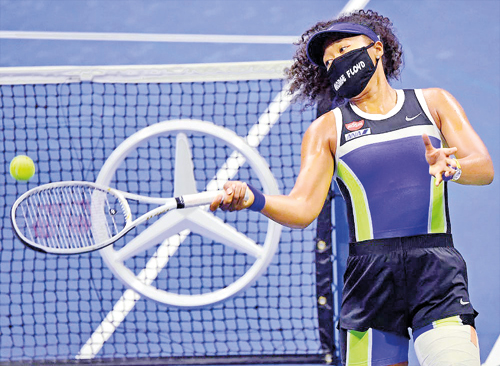An extreme year looms

Playing tennis with a face mask is not possible
Globally, during the second world war, travel was restrictive and safety was an issue. We find it to be so now. Covid-19 has affected playing the game at all levels right down to the neighbourhood tennis. Lock down means no sports. There are revolts against lock down worldwide. In the extended fight against an invisible enemy our attitude and reaction is ‘taking come what may’ attitude.
ATP arrangements
For the professionals the show must go on. Men’s ATP has come out with the first 17-week schedule for 2021 and says rest of the calendar is not changed. The schedule includes playing the Grand Slam Australian Open qualifying rounds in Doha, Qatar. Far away from Australia. ATP will use charter flights and players will be subjected to quarantine. To make it worthwhile good few events are being put together into the Australian schedule.
The scheduled events of January are scrapped or postponed to the second half of the year with the hope vaccine will be effective. Experts say even if vaccine does well, clearing up of the prevailing conditions will need time; where is the good news? Our frontline soldiers, the medics, have no time to ponder over sport frivolities, they are endangered, stressed and completely exhausted. They would like to see the end to this episode quickly than the sporting world.
Player responsibility
– face mask
Even the participatory tennis facilities are closed or restricted in all countries. Europe, Americas and Asia have declared all interactive sport are a risk. Sports, by and large is an interactive activity. No country medical platform has facilities and readiness to accommodate sick in thousands. In this situation closing sports facilities is the best option for countries. We are in a pandemic.
Playing tennis with a face mask is not possible. It restricts breathing. Social players will experience stress and may collapse using a mask. Social distancing in sports simply will not happen. Every virus detection in the sports field is a nightmare. In the past few weeks, careless professional footballers, cricketers and support workers have been detected with the virus, often attending socialising events. Premier league football had to cancel some schedules and Australia quarantined visiting cricketers. Such could be the year 2021.
Healing time
– something good
The competition tennis calendar of countries and that of the professionals are for the whole year. It defies the fact that player needs recuperation to perform well. It is a common sight to see players in support strappings in local and professional events. If you are an astute observer, you will see most right handed players have the left thigh strapped because it takes the service stress. Also, if they play double handed backhand their lower back will cause issues, however well-built they are. These are accumulated stress by playing incessantly.
Some injuries through stress in sport are for life. Federer has been nursing his knee nearly for the past one year. The modern stroke making which demands angular [rotational] movements has left many leading names with hip and knee deficiencies for life. ATP and WTA with the greatest difficulty have placed a six-week break at the end of the year. The number of obligatory events for ranking is also trimmed.
In many countries at junior level and in national level, there is no competition and off season. This leaves players exhausted and physically scarred. It is difficult to uplift their tennis playing standard. With the pandemic we are getting some recuperation time. Something good!
The edge to win
This is mystical and magical. While many appear in the top five of rankings and disappear quickly, few stay and prosper. Currently in professional women’s tennis Halep, Osaka, Serena, Kvitova, Pliskova and few others have stayed in the top 10 for a good while. In men’s Federer, Nadal, Djokovic, Thiem and Medvedev will not be forgotten easily.
How do these players maintain the edge? They bring innovation into the game. This, I believe, is the primary task of a good competition coach. Talking of their coaches, they are all good past players.
 Flight, speed and rally length
Flight, speed and rally length
While looped top spin ground strokes give less error possibilities, it also gives opponents great deal of time more. Flatter shots give less time. Generally, Nadal clears the net by 130 cm on average, Djokovic 30 to 50 cm and Federer’s average is supposedly below 30 cm. Of the three Federer gives less time to opponents. Speed wise men get closer to 200 km with their services and around 100 km average with their ground strokes.
Every addition and change in playing style of a player will take three phases. Introduction, acquiring competency and consolidation. Timewise acquiring it differs in players.
Modern players are super fast in covering the court. The only way to get the ball out of their reach is cumulatively get the player a full stride short with six or more successive placements. Easier said than done. In the net clearing height, speed and rally length formula to win, physical and mental attributes of a player matters. The other addition to this is the tactical mind set for match-play. There is only one known way to acquire tactical mind set, it is to have very good match play practice.
A happy and prosperous new year to all……….
- George Paldano, Former Int. player; Accredited Coach of German Tennis Federation; National coach Brunei and
Sri Lanka, coached ATP, WTA
and ITF top 200 ranked
players, Davis-Cup, Federation-Cup coach.
geodano2015@gmail.com


